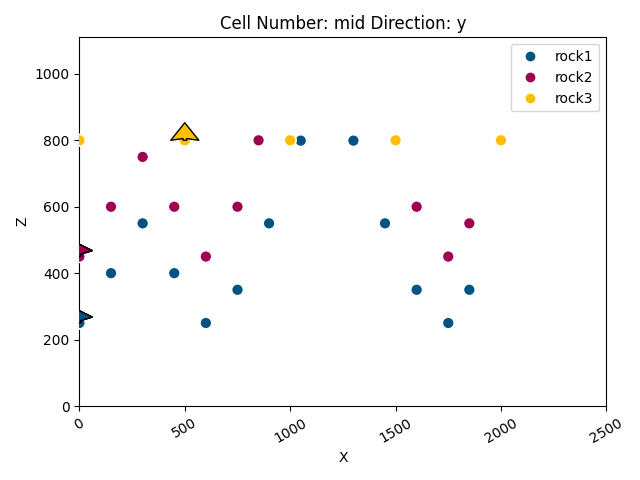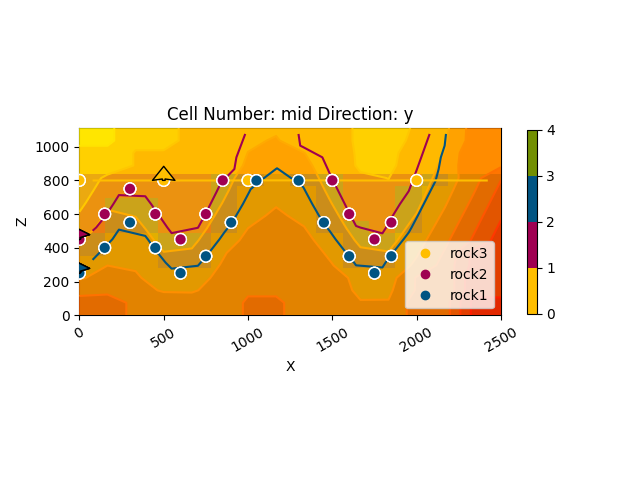Note
Go to the end to download the full example code
Modeling step by step¶
This tutorial demonstrates step-by-step geological modeling using the gempy and gempy_viewer libraries. We will start by importing the necessary packages, loading input data, creating a geological model, and then visualizing the results.
Import minimal requirements We need to import the gempy library for geological modeling and gempy_viewer for visualization.
import gempy as gp
import gempy_viewer as gpv
Define the path to input data Here, we provide two ways to define the path to the input data: using a URL or a local path. Uncomment the first two lines if you want to use the online data source.
# data_path = 'https://raw.githubusercontent.com/cgre-aachen/gempy_data/master/'
# path_to_data = data_path + "/data/input_data/jan_models/"
# For this tutorial, we will use the local path:
data_path = '../../'
path_to_data = data_path + "/data/input_data/jan_models/"
Create a GeoModel instance We create a GeoModel instance with a specified project name and extent. The ImporterHelper class is used to specify the paths to the orientation and surface points data.
geo_model = gp.create_geomodel(
project_name='tutorial_model',
extent=[0, 2500, 0, 1000, 0, 1110],
refinement=4,
importer_helper=gp.data.ImporterHelper(
path_to_orientations=path_to_data + "tutorial_model_orientations.csv",
path_to_surface_points=path_to_data + "tutorial_model_surface_points.csv"
)
)
Displaying simple data cross section We use the gempy_viewer to visualize the initial cross-section of our geological model.
gpv.plot_2d(geo_model)

<gempy_viewer.modules.plot_2d.visualization_2d.Plot2D object at 0x7ff8d33f9000>
Map geological series to surfaces Here, we map the geological series to specific surfaces. This step is crucial for defining the stratigraphic relationships in our model.
gp.map_stack_to_surfaces(
gempy_model=geo_model,
mapping_object={
"Strat_Series1": ('rock3'),
"Strat_Series2": ('rock2', 'rock1'),
}
)
Update transformation and interpolation options We update the model with anisotropy settings and specify various interpolation options to refine the model’s accuracy.
geo_model.update_transform(auto_anisotropy=gp.data.GlobalAnisotropy.CUBE)
interpolation_options: gp.data.InterpolationOptions = geo_model.interpolation_options
/home/leguark/gempy_engine/gempy_engine/core/data/transforms.py:113: RuntimeWarning: Interpolation is being done with the default transform. If you do not know what you are doing you should probably call GeoModel.update_transform() first.
warnings.warn(
Compute the geological model We use the specified backend (in this case, PyTorch) to compute the model.
gp.compute_model(
gempy_model=geo_model,
engine_config=gp.data.GemPyEngineConfig(
backend=gp.data.AvailableBackends.numpy,
dtype="float64"
)
)
Setting Backend To: AvailableBackends.numpy
Visualize the model: 2D cross-section without scalar field After computing the model, we visualize it again in 2D without the scalar field.
gpv.plot_2d(geo_model, show_scalar=False, series_n=1)

<gempy_viewer.modules.plot_2d.visualization_2d.Plot2D object at 0x7ff8d34220b0>
Visualize the model: 2D cross-section with scalar field In this cell, we visualize the 2D cross-section with the scalar field enabled. %%
gpv.plot_2d(geo_model, show_scalar=True, series_n=1)

<gempy_viewer.modules.plot_2d.visualization_2d.Plot2D object at 0x7ff8d312fb20>
Visualize the model in 3D Finally, we create a 3D visualization of the geological model without lithological coloring and image.
gpv.plot_3d(geo_model, show_lith=False, image=False)
# sphinx_gallery_thumbnail_number = -1

<gempy_viewer.modules.plot_3d.vista.GemPyToVista object at 0x7ff8d33c5ff0>
### Coming up next Additional: Manually adding data (optional) Here is an example of how you can manually add surface points to the model. Uncomment and modify the code as needed.
'''
gp.add_surface_points(
geo_model=geo_model,
x=[458, 612],
y=[0, 0],
z=[-107, -14],
elements_names=['surface1', 'surface1']
)
'''
"\ngp.add_surface_points(\n geo_model=geo_model,\n x=[458, 612],\n y=[0, 0],\n z=[-107, -14],\n elements_names=['surface1', 'surface1']\n)\n"
Displaying data cross section (optional) You can re-plot the 2D cross-section if needed. gpv.plot_2d(geo_model) %%
Total running time of the script: (0 minutes 3.085 seconds)
